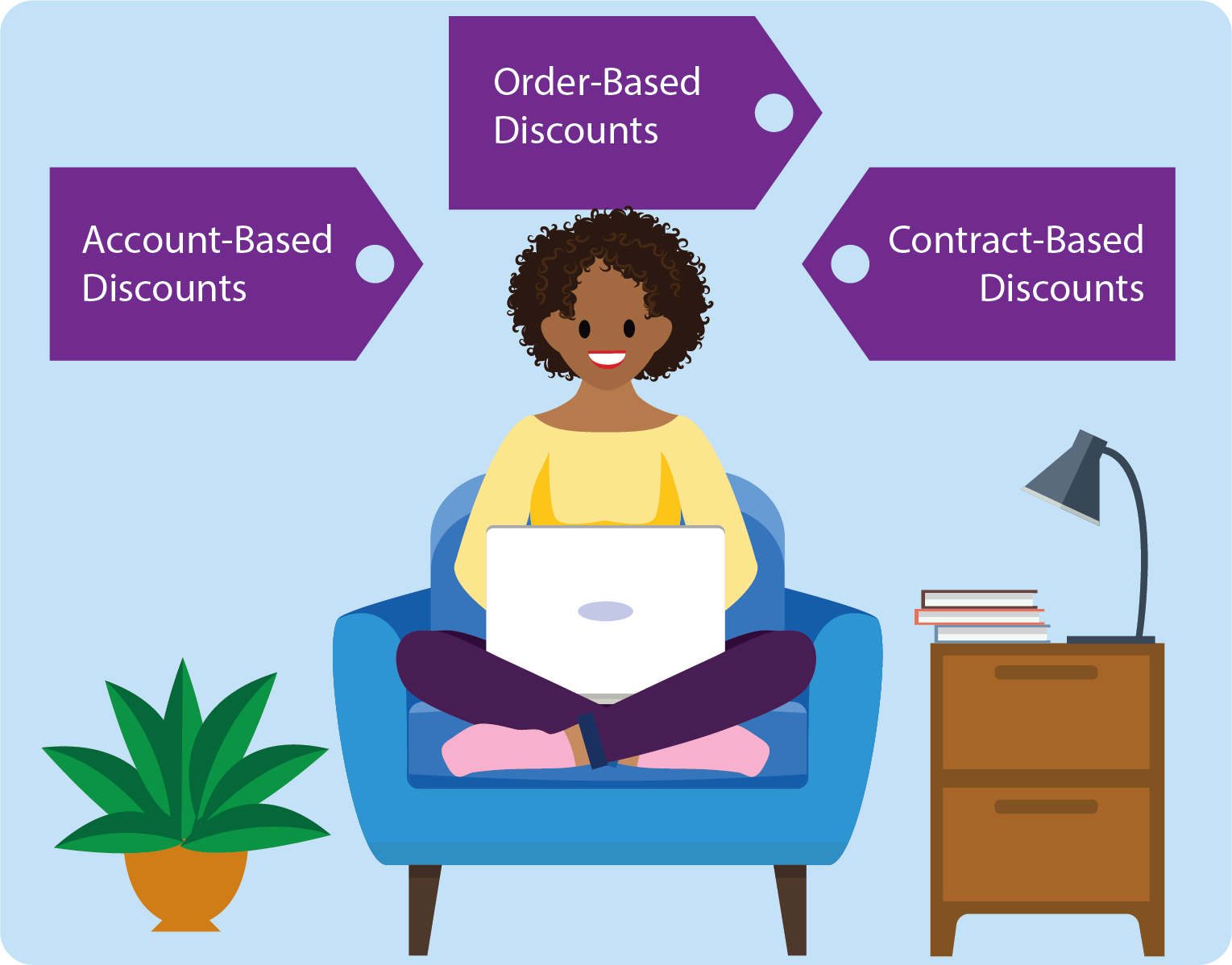Design a Discount
Learning Objectives
After completing this unit, you’ll be able to:
- List the three types of discounts supported by Industries CPQ.
- Design a discount.
Before You Start
Before you start this module, make sure you complete the following content. The work you do here builds on the concepts and work you do in that content.
Also, consider completing the following recommended content.
Review Discounts
You learned about discounts in the Industries CPQ Promotions and Discounts Exploration module. Discounts are a great way to reduce the price of:
- A product
- A category of products
- An entire catalog of products
- Individual items in the cart
- All the items in the cart
Discounts are percentages, or absolute values, that are applied to current or future purchases.
Discounts are usually associated with an account or contract and last through the duration of the contract. These discounts are often based on negotiated terms such as the volume of goods or services being purchased and the length of the contract. But discounts can also be associated with a promotion or manual adjustment.
Such discounts are applied on a case-by-case basis and are typically based on specific conditions of each order. The Promotions license also includes contextual discounts, which provide yet another way to reduce the price of products.
Discounts are great because they boost sales, support frame agreements, and support loyalty-and-retention (L&R) scenarios that attract and maintain customer approval ratings.
The product team designs and builds discounts in the Industries CPQ catalog. But customer service representatives (CSRs) and salespeople can manually adjust discounts to suit the sale or create a custom discount directly in the cart.
Infiwave, a communications service provider, uses Industries CPQ to manage its sales processes. Ada Wilson, pricing manager at Infiwave, wants to design and create discounts to boost the sales of mobile phone accessories. In this module, find out the types of discounts, and follow along as Ada designs and creates discounts with Industries CPQ.

Types of Discounts
Industries CPQ supports three types of discounts.
- Order-based
- Account-based
- Contract-based

Sign Up for a Training Playground
In this module, we show you the steps to work with discounts in Industries CPQ. We don’t have any hands-on challenges in this module, but if you want to practice and try out the steps, you need a special training org that contains Industries CPQ and our sample data. A regular Trailhead playground doesn’t have Industries CPQ or our sample data. Here’s how to get the training org now.
- Sign up for an Industries Training Playground.
- Fill out the form.
- Enter your first name and last name.
- Enter an active email address.
- Enter your company name.
- Click Sign me up. A confirmation message appears.
- Enter your first name and last name.
- When you receive the confirmation email (sometimes this takes a few minutes), log in to your training playground using the credentials in the email.
For practice exercises, check the practice guide(s) in the Resources section of units 2 and 3.
Design a Discount
Ada wants to create an order-based discount in the Shared Catalog to reduce the prices of the following mobile phone accessories by 20%.
- Tempered glass screen protector
- Infiwave ocean phone case
- Fast-charge wireless charging pad
Although the company’s CSRs and salespeople can adjust the price of each product manually in the cart, a prebuilt discount allows them to quickly incentivize sales.
Before Ada creates the discount, she must design it. Discount design is a three-step process.
- Define the discount.
- Define the discounted items.
- Define the pricing of the discounted items.
Let’s find out what each step is about.
Step 1: Define the Discount
To define the discount, consider the following questions and actions.
Question |
Do This |
|---|---|
How will you describe the discount? |
Define a clear description that lays out the details of the discount. This description is visible in the cart (for example, “20% off all mobile phone accessories”). |
What type of discount will it be? |
Define the type of discount.
|
What price list will the discount apply to? |
Choose the appropriate price list. For example, B2C or B2B. The Products list displays all available, eligible, and qualified products. |
How long will the discount apply to a customer? |
Determine if or how long the discount is available to the customer. This applies only to account- and contract-based discounts. If a duration is not specified, the discount expires on its end date. If the end date or duration is not specified, the discount never expires. After a discount expires, it becomes unavailable for future sales or orders. |
Will the discount apply to all items in the cart or specific products/sales catalogs? |
Determine whether the discount applies to all items in the cart or specific products/sales catalogs. For the order-based discount that Ada must create, the discount only applies to mobile phone accessories. |
When will the discount be available for use? |
|
Step 2: Define the Discounted Items
Now that you’ve defined the discount, you define the discounted items.
Question |
Do This |
|---|---|
What does the discount apply to? |
Select a product or sales catalog/category of products. |
What product or sales catalog/category does the discount apply to? |
Search for and select the relevant product or sales catalog/category. |
When will the discounted items be available and what is the duration of the discount? |
Determine the start date and length of time the discount will run. |
Step 3: Define the Pricing of Discounted Items
The last step is to define the pricing of discounted items. Again, you’ll need to answer a few questions and act accordingly.
Question |
Do This |
|---|---|
What price list do the discounted items apply to? |
Choose the appropriate price list, B2C or B2B. |
What pricing variables define the discount? |
Determine whether the charge type is an adjustment to the product’s price or a change to the product’s usage price. Then decide whether the sub-type charge is a standard price or a penalty fee. |
What pricing element defines the discount? |
Choose the matching pricing element if it exists. If not, create it. |
What are the start and end dates for the discounted items? |
Select Effective From and Effective Until dates. |
You Got This
Now that you’ve laid out your design, it’s time to build your discount. In the next unit, you create an order-based discount. Let’s dive in!
